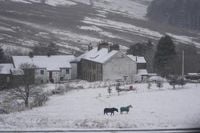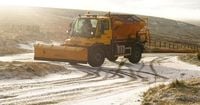The United Kingdom and Ireland are in the grip of an early winter blast, with authorities issuing a string of snow and ice warnings that stretch from the Scottish Highlands to the Midlands and across the Irish Sea. As arctic air surges in from the north, millions are facing plummeting temperatures, hazardous roads, and the first widespread taste of winter 2025.
According to the Met Office, the first notable cold snap of this autumn arrived on Tuesday night, November 18, 2025, bringing snow and ice across Northern Ireland, Scotland, and northern England. A yellow warning for snow and ice was in force across Northern Ireland from midnight until midday on Wednesday, November 19. Meanwhile, much of Scotland was under a similar yellow warning from 6pm Tuesday through to 9pm on Thursday, November 20. Large swathes of north-east England and Yorkshire also faced warnings from midnight Wednesday until the end of Thursday, with the threat of more severe amber warnings in parts of Yorkshire on Thursday.
The Met Office didn’t mince words about the risks. Chief forecaster Neil Armstrong explained, “Cold Arctic air from the north is firmly in charge of the UK’s weather, bringing the first notable cold snap of this autumn and giving an early taste of winter weather. As a result, winter hazards are likely through the next few days, with snow and ice a particular hazard, and the coldest conditions likely on Wednesday and Thursday.”
He added, “Wintry showers will affect areas exposed to the brisk northerly wind, in particular Northern Ireland, south-west Wales, south-west England, north-east England and across the northern half of Scotland. Whilst not all places will see lying snow, where showers are most frequent accumulations of 2-5cm will be possible. On higher ground in Scotland 15-20cm could accumulate and potentially as much as 15-25cm over the North York Moors and Yorkshire Wolds.”
In Northern Ireland, the wintry blast brought a mix of rain, sleet, and snow showers on Wednesday morning, with lying snow reported on mountain roads such as the Glenshane Pass and Coleraine Mountain Road. The BBC reported that commuters faced disruption, especially over higher routes, as untreated surfaces iced over and overnight temperatures fell to freezing or below. Hail and even lightning were added hazards, with the wind chill making daytime highs of 3-6°C feel much colder.
Meanwhile, the Republic of Ireland wasn’t spared. Met Éireann issued its own snow and ice warning for five counties—Cavan, Donegal, Leitrim, Monaghan, and Sligo—from midnight on Wednesday through noon Thursday. The forecast called for hail, sleet, and snow, with modest accumulations especially over high ground.
England faced its own cold weather alert, with the UK Health Security Agency (UKHSA) activating a warning for the Midlands and northern England from 8am Monday, November 17, through 8am Friday, November 21. This alert covered the East Midlands, West Midlands, North East, North West, and Yorkshire and the Humber, and was issued due to the anticipated significant health impacts of the cold. The UKHSA explained that such alerts are triggered when cold weather is forecast that could affect vulnerable groups, including the elderly and those with pre-existing health conditions.
The timing of the cold snap was abrupt. Just days before, the UK had experienced relatively mild conditions, but a shift in wind direction—driven by high pressure to the northwest—brought a cold northerly flow straight from the Arctic. Met Office deputy chief meteorologist Dan Holley noted, “This pressure will drive a cold northerly flow from the Arctic, bringing with it much colder conditions than of late.”
Saturday, November 16, saw the UK’s coldest night since March, with temperatures dropping to -7°C in Tulloch Bridge in the Scottish Highlands. By midweek, temperatures were forecast to dip even further, with lows of -7°C in some places and the possibility of -11°C in rural parts of Scotland by Thursday night, November 20. Daytime temperatures across the UK were expected to struggle into the low single figures, far below the seasonal average of around 10°C.
Simon Partridge, a Met Office meteorologist, told The Independent, “It’s certainly going to turn much colder over the next couple of days, there will be an eight to 10 degree drop in temperature, you will be struggling to get double figures. We will probably see our first widespread countrywide frost on Monday morning and the lowest temperatures will be somewhere between minus 5°C and minus 7°C.”
With frigid nights and clear skies, the risk of overnight ice was a particular concern. Armstrong of the Met Office warned, “With clear skies, overnight ice could create some particularly tricky travel conditions.” These icy patches were expected to be especially problematic on untreated surfaces, increasing the risk of accidents and travel delays.
National Highways, which oversees major roads in England, said its winter operation was in “full swing” with more than 530 gritters available nationally. Darren Clark, severe weather resilience adviser at National Highways, stated, “We have more than 530 gritters available nationally and we can rapidly call on additional reserves when snow hits or conditions demand it. We work closely with the Met Office, receiving updated forecasts throughout the day and our crews are on duty around the clock, ready to head out whenever they’re needed.” He urged drivers to prepare for winter, saying, “Quick checks, such as topping up fuel and screenwash, checking lights and tyres, and planning ahead, can make all the difference when the weather turns.”
Across Scotland, gritters were deployed as snow and ice warnings extended to major cities including Glasgow, Stirling, and Edinburgh. The Met Office cautioned that by the end of Thursday, as much as 15-25cm of snow could accumulate on hills above 100m elevation, likely causing “substantial disruption.” Power cuts and travel delays were deemed likely, with the potential to strand vehicles and passengers on affected roads.
For many, Thursday, November 20, was expected to bring a brief respite, with dry and sunny weather for most areas but continued overnight frosts. By Friday, conditions were forecast to turn milder, with rain reaching the west and temperatures rising a few degrees closer to seasonal averages.
While not all areas would see lying snow, the widespread cold and wintry hazards marked a sharp transition to winter for the UK and Ireland. With weather warnings in place and authorities on high alert, residents are reminded to take extra care—on the roads, on footpaths, and in checking on vulnerable neighbors. This early taste of winter, it seems, has arrived with a vengeance.


